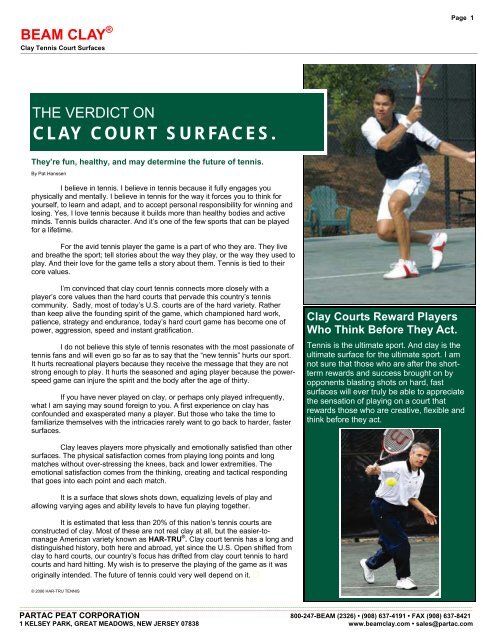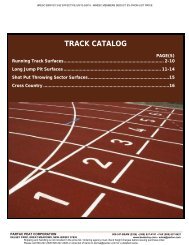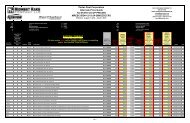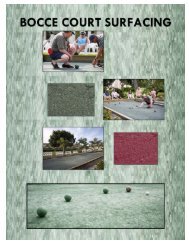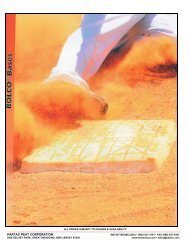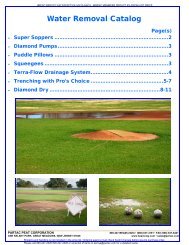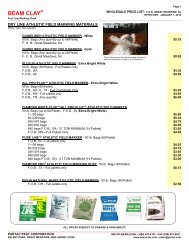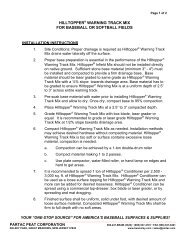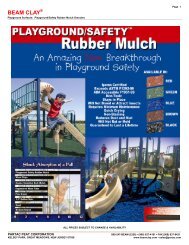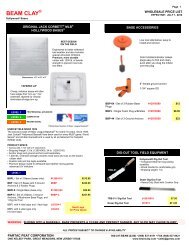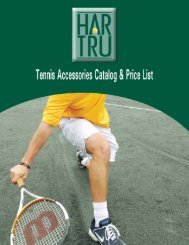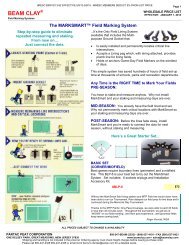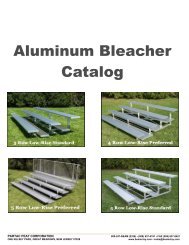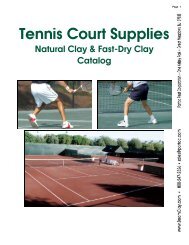8 - Tennis - Beam Clay
8 - Tennis - Beam Clay
8 - Tennis - Beam Clay
Create successful ePaper yourself
Turn your PDF publications into a flip-book with our unique Google optimized e-Paper software.
Page 1<br />
BEAM CLAY ®<br />
<strong>Clay</strong> <strong>Tennis</strong> Court Surfaces<br />
—————————————————————————————————————–———————————————————<br />
THE VERDICT ON<br />
CLAY COURT SURFACES.<br />
They’re fun, healthy, and may determine the future of tennis.<br />
By Pat Hanssen<br />
I believe in tennis. I believe in tennis because it fully engages you<br />
physically and mentally. I believe in tennis for the way it forces you to think for<br />
yourself, to learn and adapt, and to accept personal responsibility for winning and<br />
losing. Yes, I love tennis because it builds more than healthy bodies and active<br />
minds. <strong>Tennis</strong> builds character. And it’s one of the few sports that can be played<br />
for a lifetime.<br />
For the avid tennis player the game is a part of who they are. They live<br />
and breathe the sport; tell stories about the way they play, or the way they used to<br />
play. And their love for the game tells a story about them. <strong>Tennis</strong> is tied to their<br />
core values.<br />
I’m convinced that clay court tennis connects more closely with a<br />
player’s core values than the hard courts that pervade this country’s tennis<br />
community. Sadly, most of today’s U.S. courts are of the hard variety. Rather<br />
than keep alive the founding spirit of the game, which championed hard work,<br />
patience, strategy and endurance, today’s hard court game has become one of<br />
power, aggression, speed and instant gratification.<br />
I do not believe this style of tennis resonates with the most passionate of<br />
tennis fans and will even go so far as to say that the “new tennis” hurts our sport.<br />
It hurts recreational players because they receive the message that they are not<br />
strong enough to play. It hurts the seasoned and aging player because the powerspeed<br />
game can injure the spirit and the body after the age of thirty.<br />
If you have never played on clay, or perhaps only played infrequently,<br />
what I am saying may sound foreign to you. A first experience on clay has<br />
confounded and exasperated many a player. But those who take the time to<br />
familiarize themselves with the intricacies rarely want to go back to harder, faster<br />
surfaces.<br />
<strong>Clay</strong> leaves players more physically and emotionally satisfied than other<br />
surfaces. The physical satisfaction comes from playing long points and long<br />
matches without over-stressing the knees, back and lower extremities. The<br />
emotional satisfaction comes from the thinking, creating and tactical responding<br />
that goes into each point and each match.<br />
It is a surface that slows shots down, equalizing levels of play and<br />
allowing varying ages and ability levels to have fun playing together.<br />
It is estimated that less than 20% of this nation’s tennis courts are<br />
constructed of clay. Most of these are not real clay at all, but the easier-tomanage<br />
American variety known as HAR-TRU ® . <strong>Clay</strong> court tennis has a long and<br />
distinguished history, both here and abroad, yet since the U.S. Open shifted from<br />
clay to hard courts, our country’s focus has drifted from clay court tennis to hard<br />
courts and hard hitting. My wish is to preserve the playing of the game as it was<br />
originally intended. The future of tennis could very well depend on it.<br />
© 2006 HAR-TRU TENNIS<br />
<strong>Clay</strong> Courts Reward Players<br />
Who Think Before They Act.<br />
<strong>Tennis</strong> is the ultimate sport. And clay is the<br />
ultimate surface for the ultimate sport. I am<br />
not sure that those who are after the shortterm<br />
rewards and success brought on by<br />
opponents blasting shots on hard, fast<br />
surfaces will ever truly be able to appreciate<br />
the sensation of playing on a court that<br />
rewards those who are creative, flexible and<br />
think before they act.<br />
________________________________________________________________________________________________________________________________________________________________________________________________________________________________<br />
________________________________________________________________________________________________________________________________________________________________________________________________________________________________<br />
PARTAC PEAT CORPORATION 800-247-BEAM (2326) • (908) 637-4191 • FAX (908) 637-8421<br />
1 KELSEY PARK, GREAT MEADOWS, NEW JERSEY 07838 www.beamclay.com • sales@partac.com
BEAM CLAY ®<br />
<strong>Clay</strong> <strong>Tennis</strong> Court Surfaces<br />
Page 2<br />
WHOLESALE PRICE LIST<br />
EFFECTIVE: JANUARY 1, 2011<br />
—————————————————————————————————————–———————————————————<br />
TENNIS SURFACES<br />
BEAM CLAY ® FOR NATURAL CLAY TENNIS COURTS<br />
New Construction: 4" recommended; approx. 30 tons per 1" compacted over 60’ x 120’ court. BULK PER TON PER BAG<br />
<strong>Tennis</strong> Court <strong>Clay</strong> - Red (Extra Firm) 50 (50# bags)/pallet<br />
- Orange (Extra Firm) 50 (50# bags)/pallet<br />
- Brown (Extra Firm) 50 (50# bags)/pallet<br />
- Grey (Medium Firm) 50 (50# bags)/pallet<br />
- Tan (Medium Firm) 50 (50# bags)/pallet<br />
- Orange (Medium Firm) 50 (50# bags)/pallet<br />
Red Slate Top-Dressing 50 (50#) bags/pallet<br />
Brick Dust Top-Dressing 50 (50#) bags/pallet<br />
Red Lava Dust Top-Dressing 90 (1/2 c.f.) bags/pallet<br />
Magnesium Chloride Flakes 48 (50#) bags/pallet<br />
Magnesium Chloride Pellets 48 (50#) bags/pallet<br />
Calcium Chloride Flakes 56 (50#) bags/pallet<br />
Calcium Chloride Pellets 56 (50#) bags/pallet<br />
FULL OR PARTIAL PALLETS: PALLET & COVER CHARGES: $6.50/PALLET<br />
Please see instructions for constructing and maintaining natural clay tennis courts.<br />
CALIFORNIA PRO GOLD TENNIS COURT CLAY<br />
Extra Firm Reddish-Brown, F.O.B., CA, 40 (50#) bags/pallet.<br />
NORTHEAST ® TENNIS COURT FAST-DRY SURFACES<br />
$125.00<br />
$115.00<br />
$115.00<br />
$105.00<br />
$105.00<br />
$115.00<br />
$110.00<br />
$115.00<br />
$202.00<br />
PER BAG<br />
F.O.B. VT,<br />
PLANT<br />
—<br />
—<br />
—<br />
—<br />
$9.50<br />
$8.50<br />
$8.50<br />
$6.50<br />
$6.50<br />
$8.50<br />
$8.50<br />
$8.50 $5.50<br />
$16.95<br />
$18.25<br />
$17.95<br />
$18.95<br />
— $10.50<br />
PER BAG<br />
F.O.B., NJ<br />
WARE-<br />
HOUSE<br />
New Construction: 1,000 - 80# bags (40 tons) = 1¼" loose per court = 1" compacted over a 60’ x 120’ court. Full pallets only from plants; any quantity from NJ.<br />
PLEASE NOTE: Northeast pricing includes cost of pallet and shrink wrap, or pallet and bulk bag. Add $6.50 for partial pallets from NJ.<br />
NORTHEAST ® (VT) - Green 35 (80#) bags/pallet<br />
- Green 48 (50#) bags/pallet<br />
- Green Bulk Bag<br />
- Red 35 (80#) bags/pallet<br />
- Red Bulk Bag<br />
$5.50<br />
$3.70<br />
$152.50/T<br />
$7.30<br />
$197.50/T<br />
MAGNESIUM CHLORIDE FLAKES 40 (50#) bags/pallet $18.70<br />
Please see instructions for constructing and maintaining Fast-Dry <strong>Tennis</strong> Courts.<br />
ALL PRICES SUBJECT TO CHANGE & AVAILABILITY<br />
F.O.B. GREAT MEADOWS<br />
__________________________________________________________________________________________________________________________________________________________________________________________________________________________<br />
__________________________________________________________________________________________________________________________________________________________________________________________________________________________<br />
PARTAC PEAT CORPORATION 800-247-BEAM (2326) • (908) 637-4191 • FAX (908) 637-8421<br />
ONE KELSEY PARK, GREAT MEADOWS, NEW JERSEY 07838 www.beamclay.com • sales@partac.com<br />
$7.50<br />
$5<br />
$203/T<br />
$9.30<br />
$248/T
BEAM CLAY ®<br />
<strong>Clay</strong> <strong>Tennis</strong> Court Surfaces<br />
Page 3<br />
WHOLESALE PRICE LIST<br />
EFFECTIVE: JANUARY 1, 2011<br />
—————————————————————————————————————–———————————————————<br />
TENNIS SURFACES<br />
HAR-TRU ® TENNIS COURT FAST-DRY SURFACES<br />
New Construction: 1,000 - 80# bags (40 tons) = 1¼" loose per court = 1" compacted over a 60’ x 120’ per court. Full pallets only from plants; any<br />
quantity from NJ. PLEASE NOTE: Har-Tru pricing includes cost of pallet & stretch wrap, or pallet and bulk bag. Add $5.50 for pallet covers. Add<br />
$6.50 for partial pallets from NJ.<br />
Please see instructions for constructing and maintaining Fast-Dry <strong>Tennis</strong> Courts.<br />
Har-Tru ® Surfacing<br />
TCMHT8014 1.4 TON (80 LB. BAGS—35/PALLET) $5.95 $7.85<br />
TCMHT8010 1 TON (80 LB. BAGS—25/PALLET) $6.25 $8.19<br />
TCMHT5014 1.4 TON (50 LB. BAGS—56/PALLET) $4.15 $5.35<br />
TCMHT5010 1 TON (50 LB. BAGS—40/PALLET) $4.40 $5.61<br />
TCMHT2000 2,000 LB. BULK BAG $185 $235<br />
TCMHT2500 2,500 LB. BULK BAG $225 $285<br />
TCMHT2800 2,800 LB. BULK BAG $235 $305<br />
Har-Tru ® Top-Dressing<br />
TCMTD8014 1.4 TON (80 LB. BAGS—35/PALLET) $5.85 $7.75<br />
TCMTD8010 1 TON (80 LB. BAGS—25/PALLET) $6.25 $8.19<br />
HyroBlend For Sub-Irrigated <strong>Tennis</strong> Courts<br />
TCMHB8014 1.4 TON (80 LB. BAGS—35/PALLET) $5.95 $7.85<br />
TCMHB8010 1 TON (80 LB. BAGS—25/PALLET) $6.15 $8.10<br />
TCMHB5014 1.4 TON (50 LB. BAGS—56/PALLET) $6.60 $7.80<br />
TCMHB5010 1 TON (50 LB. BAGS—40/PALLET) $7.00 $8.20<br />
TCMHB2000 2,000 LB. BULK BAG $180 $229<br />
TCMHB2500 2,500 LB. BULK BAG $210 $270<br />
TCMHB2800 2,800 LB. BULK BAG $235 $305<br />
Coarse Blend For Sub-Irrigated <strong>Tennis</strong> Courts<br />
TCMCB7513 1.3 TON (75 LB. BAGS—35/PALLET) $7.00 $8.80<br />
American Red For Sub-Irrigated <strong>Tennis</strong> Courts<br />
TCMAR7014 AMERICAN RED / 1.4 TON (70 LB. BAGS—40/PALLET) $8.85 $10.50<br />
TCMAR2000 AMERICAN RED (2,000 LB. BAG) $305 $350<br />
Calcium Chloride (50 LB. BAGS)<br />
SOLCALTCM CALCIUM CHLORIDE WITH TRUCK LOAD $19.25 —<br />
SOLCALWOT CALCIUM CHLORIDE BY COMMON CARRIER $21.00 —<br />
Magnesium Chloride (50 LB. BAGS)<br />
SOLMAGTCM MAGNESIUM CHLORIDE WITH TRUCK LOAD $19.00 —<br />
SOLMAGWOT MAGNESIUM CHLORIDE BY COMMON CARRIER $20.00 —<br />
Please see instructions for constructing and maintaining Fast-Dry <strong>Tennis</strong> Courts.<br />
PER BAG<br />
F.O.B., VA<br />
PLANT<br />
ALL PRICES SUBJECT TO CHANGE & AVAILABILITY<br />
PER BAG<br />
F.O.B., NJ<br />
WAREHOUSE<br />
__________________________________________________________________________________________________________________________________________________________________________________________________________________________<br />
__________________________________________________________________________________________________________________________________________________________________________________________________________________________<br />
PARTAC PEAT CORPORATION 800-247-BEAM (2326) • (908) 637-4191 • FAX (908) 637-8421<br />
ONE KELSEY PARK, GREAT MEADOWS, NEW JERSEY 07838 www.beamclay.com • sales@partac.com
Page 4<br />
BEAM CLAY ®<br />
Har-Tru ® Fast-Dry <strong>Tennis</strong> Court Surfaces<br />
—————————————————————————————————————–———————————————————<br />
TIP<br />
Fall top-dressing is just<br />
as effective as spring topdressing<br />
and can allow a<br />
seasonal club to open its<br />
courts weeks earlier in<br />
the springtime.<br />
Reduced Injuries<br />
Har-Tru ® responds to a player’s<br />
movements, preventing the twisting<br />
and jarring that occurs on<br />
hard surfaces.<br />
More Frequent Play<br />
Less physical toll allows players<br />
to play longer and recover more<br />
quickly.<br />
Longer Rallies<br />
Players get to more shots, allowing<br />
not just longer rallies but more<br />
creative, inspiring points.<br />
Rapid Drying Times<br />
Har-Tru ® courts stay playable during<br />
light rains and dry quickly after<br />
thunderstorms.<br />
Courts That Last<br />
Other courts may crack and<br />
bulge, but a Har-Tru ® court moves<br />
with the earth below and can last<br />
a lifetime.<br />
Easy To Build<br />
A Har-Tru ® court can be built almost<br />
anywhere, including on top<br />
of old, cracked asphalt courts.<br />
Due to the surface’s porous nature,<br />
it solves run-off control problems<br />
and will satisfy impervious<br />
surface restrictions in most<br />
cases.<br />
HAR-TRU ® FAST-DRY TENNIS COURTS<br />
More tennis courts are being converted to clay courts than ever before in the history<br />
of tennis. That’s because clay court tennis brings players more enjoyment and<br />
fewer injuries at every stage of life. <strong>Clay</strong> courts allow tennis players to slide, which<br />
means they can play for as long and as often as they like without overstressing the<br />
knees, back and lower extremities.<br />
Har-Tru ® is the most popular clay court surfacing in the United States and comes in<br />
80 lb. bags, 50 lb. bags, as well as 2,000 lb., 2,500 lb., and 2,800 lb. disposable<br />
bulk bags.<br />
<<br />
<<br />
HAR-TRU ®<br />
<strong>Tennis</strong> court surfacing with binder. For use on Har-Tru<br />
courts with sprinkler systems.<br />
Available in:<br />
• 1.0 ton pallet with 80 lb. bags<br />
• 1.4 tons per pallet with 80 lb. bags<br />
• 1.0 ton pallet with 50 lb. bags<br />
• 1.4 tons per pallet with 50 lb. bags<br />
• 2000 lb. bulk bag<br />
• 2500 lb. bulk bag<br />
• 2800 lb. bulk bag<br />
HAR-TRU ® COARSE BLEND<br />
Coarse surface manufactured for indoor and<br />
outdoor sub-irrigated courts where extra<br />
coarseness and sliding material are needed.<br />
Available only in:<br />
1.3 ton pallet with 75 lb. bags<br />
HYDROBLEND<br />
<strong>Tennis</strong> court surfacing material for<br />
sub-irrigated tennis courts.<br />
Available in:<br />
• 1.0 ton pallet with 80 lb. bags<br />
• 1.4 tons per pallet with 80 lb. bags<br />
• 2000 lb. bulk bag<br />
• 2500 lb. bulk bag<br />
• 2800 lb. bulk bag<br />
AMERICAN RED CLAY<br />
<strong>Tennis</strong> court surfacing material<br />
for use on red sub-irrigated tennis<br />
courts or for top dressing a variety<br />
of natural clay courts.<br />
Available only in:<br />
• 1.4 ton pallet with 70 lb. bags<br />
• 2000 lb. bulk bag<br />
ALL PRICES SUBJECT TO CHANGE & AVAILABILITY<br />
__________________________________________________________________________________________________________________________________________________________________________________________________________________________<br />
__________________________________________________________________________________________________________________________________________________________________________________________________________________________<br />
PARTAC PEAT CORPORATION 800-247-BEAM (2326) • (908) 637-4191 • FAX (908) 637-8421<br />
ONE KELSEY PARK, GREAT MEADOWS, NEW JERSEY 07838 www.beamclay.com • sales@partac.com<br />
><br />
>
Page 5<br />
BEAM CLAY ®<br />
Har-Tru HydroCourt<br />
—————————————————————————————————————–———————————————————<br />
HydroCourt is a self-regulating irrigation system that waters the court from below. Each court is constructed with six, fully lined,<br />
individually controlled cells. Each cell is monitored by a water control box allowing adjustments to be fine tuned to player preferences.<br />
Increasing the water in the control boxes increases the water level in the court. Once the appropriate water level is<br />
achieved a float valve and an overflow pipe inside the control box keep the water level constant. It’s that simple!<br />
HydroCourt is time tested in great numbers all across the globe. Well over 1,000 courts have been installed since 1985 in the<br />
US alone. And the HydroCourt system has been proven in every climate imaginable including countries like Canada, England,<br />
France, Japan, Qatar, Spain, Tortola, Turkey and more.<br />
Why do people choose HydroCourt?<br />
1. Perfect Playing Conditions 24/7. HydroCourts stay uniformly wet, smooth and firm for a consistent bounce and<br />
exceptional footing.<br />
2. More available court time. HydroCourt technology eliminates midday shut downs and improves drainage. Hydro-<br />
Courts are playable during light rain and dry rapidly after a heavy one.<br />
3. Maintenance is cut in half. Rolling is needed infrequently, brushing is required once a day and watering is completed<br />
automatically and uses 40% less.<br />
4. Comfort. With water rising from below, some people feel like HydroCourts are air conditioned; they can be as<br />
much as 20 degrees cooler than a hard court.<br />
HydroCourt Brochure<br />
HydroCourt Construction Specifications (Updated)<br />
HydroCourt Owner-Users Manual (Updated)<br />
Maintenance Information<br />
“We needed a top-class surface for pros and members. The reduced amount of maintenance downtime and increased playing<br />
season has been an added bonus.” –Peter Elviss, Chief Executive, West Hants Club, Bournemouth, England<br />
“Our guests expect the very best amenities, service and playing experience and this is why we chose HydroCourt.”<br />
–Cliff Drysdale, ABC and ESPN commentator and Director of <strong>Tennis</strong> at The Ritz Carlton, Key Biscayne, FL<br />
“HydroCourt is ideal for our southwestern desert climate.” –Tim Bakels, General Manager and Vice President, Desert Highlands<br />
Association, Scottsdale, AZ<br />
“<strong>Tennis</strong> professionals know the advantage of clay courts, but dread the maintenance that comes with clay courts. HydroCourt<br />
has come to the rescue. Once you establish the settings, the court waters itself with no downtime, so members can enjoy playing<br />
tennis from morning till night. I highly recommend the HydroCourt system to anyone who is serious about building a clay<br />
court.” –Larry Schnall, <strong>Tennis</strong> Director, Marietta Country Club, Kennesaw, GA<br />
ALL PRICES SUBJECT TO CHANGE & AVAILABILITY<br />
__________________________________________________________________________________________________________________________________________________________________________________________________________________________<br />
__________________________________________________________________________________________________________________________________________________________________________________________________________________________<br />
PARTAC PEAT CORPORATION 800-247-BEAM (2326) • (908) 637-4191 • FAX (908) 637-8421<br />
ONE KELSEY PARK, GREAT MEADOWS, NEW JERSEY 07838 www.beamclay.com • sales@partac.com
Page 6<br />
BEAM CLAY ®<br />
<strong>Tennis</strong> Courts - Constructing Natural <strong>Clay</strong> <strong>Tennis</strong> Courts<br />
—————————————————————————————————————–———————————————————<br />
RECOMMENDATIONS FOR CONSTRUCTING NATURAL CLAY TENNIS COURTS (120' X 60')<br />
SITE PREPARATION:<br />
Clear site of all vegetation and top soil. Length of court, if possible, should be in a north/south position.<br />
GRADING:<br />
Natural clay courts need more slope for proper surface drainage than fast-dry courts, 1” in 20’ (after compaction) versus 1” in 30’ (after<br />
compaction) for fast-dry courts. Grade area on a true plane, preferably from side to side (but from end to end or from corner to corner are<br />
acceptable), or in the shortest direction for good drainage/water run-off.<br />
DRAINAGE BED (Base Course):<br />
Drainage bed may vary drastically depending on the existing sub-drainage conditions. Create a firm drainage base, minimum 3" deep (after<br />
compaction), of 3/4" minus crushed stone (with fines) maintaining above slope.<br />
PRE-CLAY COURSE:<br />
Apply 1/2" of stone screenings, true to grade.<br />
CLAY PLAYING SURFACE:<br />
For Natural <strong>Clay</strong> Courts<br />
Apply approximately 5-1/4" of BEAM CLAY® <strong>Tennis</strong> Court <strong>Clay</strong> over court. This will compact to approximately 4". This will require<br />
approximately 120 tons of BEAM CLAY® <strong>Tennis</strong> Court <strong>Clay</strong>. It is generally best to construct a screed system with 2" x 6"'s true to grade,<br />
installing loose clay between the planks and pulling a board across to maintain even grades.<br />
After clay application, court should have a thorough soaking by rain to insure even distribution of moisture. Check for low spots; fill with<br />
BEAM CLAY® <strong>Tennis</strong> Court <strong>Clay</strong>; thoroughly saturate filled areas.<br />
Once clay has dried enough that it will not adhere to a 1/2 ton roller, roll in both directions several times. Allow court to dry thoroughly and<br />
mat with a 6' wide rigid steel drag leveling mat to a powdery surface. Broom court in both directions.<br />
After drying further, court surface will crack and continue to crack until sufficiently compacted.<br />
After another wetting by rain and drying to proper moisture content, rework surface as above.<br />
PLEASE NOTE: <strong>Clay</strong> courts will crack at first and must be rolled and broomed until cracks get smaller and smaller and disappear. A clay<br />
court that cracks the 1st year will in later years have a long useful life; a court that doesn't crack at first is too sandy, will wear out<br />
prematurely and will require more maintenance in later years. Natural clay court construction in northern climates is best done in the fall so<br />
that courts have a chance over winter to naturally compact.<br />
Once cracking becomes sufficiently small (hair-line cracks) apply 1,000 lbs. of top-dressing and thoroughly broom in both directions. Roll<br />
again. If top-dressing is applied too soon, it will fill the cracks but (by working into the clay) shorten the long-term life of the court.<br />
Apply 300 lbs. of magnesium or calcium chloride (flakes). After magnesium or calcium chloride thoroughly dissolves and court reaches<br />
proper moisture content (12 to 24 hours), court should be rebroomed and compacted (rolled).<br />
Install marking tape and center pin. Ready for play.<br />
After rain, re-broom and roll court when surface has dried. Apply top-dressing and calcium chloride as needed during season. Normally, 3-4<br />
applications are sufficient for season.<br />
ALL PRICES SUBJECT TO CHANGE & AVAILABILITY<br />
__________________________________________________________________________________________________________________________________________________________________________________________________________________________<br />
__________________________________________________________________________________________________________________________________________________________________________________________________________________________<br />
PARTAC PEAT CORPORATION 800-247-BEAM (2326) • (908) 637-4191 • FAX (908) 637-8421<br />
ONE KELSEY PARK, GREAT MEADOWS, NEW JERSEY 07838 www.beamclay.com • sales@partac.com
Page 7<br />
BEAM CLAY ®<br />
<strong>Tennis</strong> Courts - Maintaining Natural <strong>Clay</strong> <strong>Tennis</strong> Courts<br />
—————————————————————————————————————–———————————————————<br />
RECOMMENDATIONS FOR RECONDITIONING NATURAL CLAY COURTS AFTER WINTER SEASON<br />
1. Remove marking tapes and center pin. Sweep or blow top-dressing from court. In northern climates this is best done in the Fall<br />
when closing courts.<br />
2. Scarify court with drag mat. Then broom in both directions, north/south and east/west.<br />
3. After natural wetting by rain, check for low spots; fill with BEAM CLAY® <strong>Tennis</strong> Court <strong>Clay</strong>, working into the existing surface for<br />
good bonding. Thoroughly saturate filled areas.<br />
4. When court has dried to sufficient moisture content, compact with 1/2 ton roller in both directions several times. Allow court to dry<br />
thoroughly and mat with a 6' wide rigid steel drag leveling mat to a powdery surface. Broom court in both directions.<br />
5. Apply approximately 1,000 lbs. of top-dressing per court. Broom in both directions.<br />
6. Apply 300 lbs. of magnesium or calcium chloride (flakes) per court. After flakes thoroughly dissolve and court reaches proper<br />
moisture content (12-24 hours), court should be re-broomed and compacted (rolled).<br />
7. Reapply marking tapes and center pin.<br />
8. After rain, re-broom and roll court when surface has dried. Apply top-dressing and calcium chloride as needed during season.<br />
Normally, 3-4 applications are sufficient for season.<br />
RECOMMENDATIONS FOR RESURFACING NATURAL CLAY TENNIS COURTS<br />
1. Remove marking tape and center pin. Sweep or blow top-dressing from court.<br />
2. Scarify court approximately 1/2" in depth.<br />
3. Apply 1"+ of BEAM CLAY® <strong>Tennis</strong> Court <strong>Clay</strong>.<br />
4. Rescarify to blend BEAM CLAY® with existing surface. Then drag mat entire court.<br />
5. After a natural wetting by rain, check for low spots; fill with BEAM CLAY® <strong>Tennis</strong> Court <strong>Clay</strong>. Thoroughly saturate filled areas.<br />
6. When court has dried to sufficient moisture content, compact with 1/2 ton roller in both directions several times. Allow court to dry<br />
thoroughly and mat with a 6' wide rigid steel drag leveling mat to a powdery surface. Broom court in both directions.<br />
7. Court surface will continue to crack until sufficiently compacted. After another wetting by rain and drying to proper moisture content,<br />
rework surface as above.<br />
8. PLEASE NOTE: <strong>Clay</strong> courts will crack at first and must be rolled and broomed until cracks get smaller and smaller and disappear.<br />
A clay court that cracks the 1st year will in later years have a long useful life; a court that doesn't crack at first is too sandy, will<br />
wear out prematurely, and will require more maintenance in later years.<br />
9. Once cracking becomes sufficiently small (hair-line cracks) apply 1,000 lbs. top-dressing and thoroughly broom in both directions.<br />
Roll again.<br />
10. Apply 300 lbs. of magnesium or calcium chloride (flakes) per court. After flakes thoroughly dissolve and court reaches proper<br />
moisture content (12 to 24 hours), court should be re-broomed and compacted (rolled).<br />
11. Reapply marking tapes and center pin. Ready for play.<br />
12. After rain, re-broom and roll court when surface has dried. Apply top-dressing and calcium chloride as needed during season.<br />
Normally, 3-4 applications are sufficient for season.<br />
ALL PRICES SUBJECT TO CHANGE & AVAILABILITY<br />
__________________________________________________________________________________________________________________________________________________________________________________________________________________________<br />
__________________________________________________________________________________________________________________________________________________________________________________________________________________________<br />
PARTAC PEAT CORPORATION 800-247-BEAM (2326) • (908) 637-4191 • FAX (908) 637-8421<br />
ONE KELSEY PARK, GREAT MEADOWS, NEW JERSEY 07838 www.beamclay.com • sales@partac.com
Page 8<br />
BEAM CLAY ®<br />
<strong>Tennis</strong> Courts - Constructing Fast-Dry <strong>Tennis</strong> Courts<br />
—————————————————————————————————————–———————————————————<br />
RECOMMENDATIONS FOR CONSTRUCTING & MAINTAINING FAST-DRY TENNIS COURTS<br />
CONSTRUCTION<br />
Careful planning for site selection, orientation and layout will result in the most advantageous use of your court during the entire playing<br />
season — depending upon our geographic location. The following are our guidelines for site selection and construction of a typical fast-dry<br />
tennis court.<br />
SITE SELECTION AND PREPARATION<br />
Orient your court layout as close to North and South as possible. Select a well drained site. All trees and above surface growth must be<br />
cleared as well as sub-surface growth such as root systems. Also, excavate all top soils and other unsuitable soils down to a clay or<br />
hardpan base. The excavation must be deep enough to allow the finished surface to be six inches above adjacent grade. If it is impractical<br />
to allow any required fill to settle over a winter, then the fill can be built up not more than six inch layers, and compact each layer. Add<br />
moisture when compacting extremely dry soils. Ninety-five percent compaction is recommended for the foundation.<br />
GRADING<br />
Allow at least three feet beyond all curb and fence lines. More if a major cut is required. Rough grading should be within plus or minus one<br />
inch of finished sub-grade. Grade on a true place, with a slope of one inch in thirty feet, preferably from side to side (but from end to end or<br />
from corner to corner also are acceptable), or in the shortest direction for good drainage/water run-off. The court should never be sloped<br />
from the net line to the baseline, from the baseline to the netline, from the side to the centerline or from the centerline to the sides.<br />
SPRINKLER SYSTEM<br />
A sprinkler system is recommended instead of watering by hand. Piping and valves should be installed prior to leveling the stone. The<br />
standpipes and sprinkler heads should be installed after surface is completed. The system should have adequate sprinklers to provide full<br />
coverage of the court area. In some climates, a combination of sprinklers and sub surface irrigation can be used for supplying water to the<br />
court. Locations with little rainfall and expensive water costs should consider this combination of sub surface irrigation along with surface<br />
sprinklers. Extensive research should be made prior to the final decision on the sprinkler system as to water pressure and the gallons per<br />
minute.<br />
PERIMETER EDGING<br />
An edging of brick or block set in cement mortar, treated wood timber or concrete should be installed around the entire perimeter of the court<br />
area. The finished curb elevation should be 1/2” below the finished court surface, after compaction, and the court surface should be tapered<br />
from approximately 2’ out to meet the top of the edging.<br />
STONE BASE<br />
The base of a fast-dry court must be stable and porous. Avoid materials that shift or crawl when rolled, or that move when subjected to<br />
freezing and thawing conditions. The base must be porous to absorb excess water from the surface. This is the fast-drying quality that<br />
allows play within a very short time after a rain. Also, the absorbed water is later fed back to the surface, maintaining proper moisture for<br />
best play. Too much compacting will create an impervious base, resulting in insufficient moisture penetration and exchange. 3/4” crushed<br />
stone with fines is the preferred base material. However, other materials, such as cinders, old slag or crushed pit gravel may be used.<br />
The average thickness of the base is four inches, with the top one-half inch consisting of stone screenings.<br />
COURT SURFACING<br />
On the finished stone base a 1-1/4” (one inch compacted) layer of fast-dry surfacing is installed. The material is laser-graded or spread with<br />
rakes and leveled by hand with a straightedge set atop screed strips. Since the base was placed to true grade, the screed strips are<br />
checked only for accuracy to assure uniform surface thickness. The dry surfacing is soaked with water and allowed to dry for 15 minutes to<br />
set up. Then a 600—1,000 pound roller is used to compact the material to one inch. Once the entire area is covered with surfacing, daily<br />
watering and rolling should be done for at least a week to insure proper compaction prior to heavy usage.<br />
NET POSTS<br />
The net posts are positioned according to the U.S.T.A. The post footers should be 30” x 18” x 30” and filled with concrete up to 1” from the<br />
surface level (to top of stone base). After the concrete has set, the area is filled with surfacing to conform to the rest of the court.<br />
CENTERGUIDES & PLAYING LINES<br />
Centerguides are galvanized pipe 12” - 18” long, installed in the ground and with a cross pin to attach the centerstrap hasp. The<br />
recommended line tapes are two inches wide and held in place with 2-1/2” - 3” nails. Position the lines in accordance with the U.S.T.A.<br />
ALL PRICES SUBJECT TO CHANGE & AVAILABILITY<br />
__________________________________________________________________________________________________________________________________________________________________________________________________________________________<br />
__________________________________________________________________________________________________________________________________________________________________________________________________________________________<br />
PARTAC PEAT CORPORATION 800-247-BEAM (2326) • (908) 637-4191 • FAX (908) 637-8421<br />
ONE KELSEY PARK, GREAT MEADOWS, NEW JERSEY 07838 www.beamclay.com • sales@partac.com
Page 9<br />
BEAM CLAY ®<br />
<strong>Tennis</strong> Courts - Constructing Fast-Dry <strong>Tennis</strong> Courts<br />
—————————————————————————————————————–———————————————————<br />
Construction & Installation<br />
Cross Section of Fast-Dry <strong>Tennis</strong> Court<br />
ALL PRICES SUBJECT TO CHANGE & AVAILABILITY<br />
__________________________________________________________________________________________________________________________________________________________________________________________________________________________<br />
__________________________________________________________________________________________________________________________________________________________________________________________________________________________<br />
PARTAC PEAT CORPORATION 800-247-BEAM (2326) • (908) 637-4191 • FAX (908) 637-8421<br />
ONE KELSEY PARK, GREAT MEADOWS, NEW JERSEY 07838 www.beamclay.com • sales@partac.com
Page 10<br />
BEAM CLAY ®<br />
<strong>Tennis</strong> Courts - Constructing Fast-Dry <strong>Tennis</strong> Courts<br />
—————————————————————————————————————–———————————————————<br />
BUILDING YOUR FAST-DRY TENNIS COURT<br />
TRADITIONAL BASE<br />
For multiple courts and courts<br />
With heavy play.<br />
curb in mortar bed<br />
CONVERSION OF HARD COURTS<br />
Your old, cracked hard courts can be<br />
converted to soft fast-dry courts. You<br />
simply change the pitch with suitable<br />
fill and build right on top of your<br />
existing courts.<br />
1” fast-dry surface<br />
1” leveling course of<br />
1/4” stone with fines<br />
3” of 3/4” stone with fines<br />
CURB OR WOOD HEADER<br />
IMPROVING CLAY COURTS<br />
MODIFIED SCREENING BASE<br />
An acceptable alternative base for all<br />
applications especially where precise<br />
grade control can be achieved.<br />
curb in mortar bed<br />
TOP DRESSING<br />
LINE<br />
TAPE<br />
EXISTING CLAY COURT<br />
ALL PRICES SUBJECT TO CHANGE & AVAILABILITY<br />
Approximately 2-1/2” of<br />
1/4” stone with fines<br />
1” fast-dry surface<br />
__________________________________________________________________________________________________________________________________________________________________________________________________________________________<br />
__________________________________________________________________________________________________________________________________________________________________________________________________________________________<br />
PARTAC PEAT CORPORATION 800-247-BEAM (2326) • (908) 637-4191 • FAX (908) 637-8421<br />
ONE KELSEY PARK, GREAT MEADOWS, NEW JERSEY 07838 www.beamclay.com • sales@partac.com
Page 11<br />
BEAM CLAY ®<br />
<strong>Tennis</strong> Courts - Maintaining Fast-Dry <strong>Tennis</strong> Courts<br />
—————————————————————————————————————–———————————————————<br />
MAINTENANCE<br />
The following suggestions for maintaining a fast-dry tennis court are simply basic guidelines. Local climate, soil conditions and court layout<br />
will determine specific maintenance procedures. Each court must establish its own maintenance policy, using our guidelines in conjunction<br />
with its own requirements and capabilities.<br />
BRUSHING<br />
Brushing is most important in court maintenance, requiring a minimum amount of time. Brushing keeps the surface level, assuring an even<br />
distribution of the surface granules. At the end of each day’s play, the court must be brushed. However, if the court is in continuous use, we<br />
recommend a mid-day brushing as well. Also, brush the court before rolling. Brush the court lengthwise and crosswise, taking particular<br />
care to eliminate accumulations of loose particles. When brushing, pull the brush behind you in a continuous pass, making a turn at the end<br />
of each sweep.<br />
WATERING<br />
A fast-dry tennis court plays best when slightly damp, exhibiting its characteristic dark green or red color. A grayish or pink appearing<br />
surface indicates that the court needs watering. The amount of water you must apply to dampen the surface to its optimum playing condition<br />
depends upon the amount of water retained in the base at this time. In learning to judge the correct application, experience it through trial<br />
and error is your surest guide. We do recommend that the court be watered at night after it has been brushed. As noted elsewhere, a<br />
sprinkler system is most effective, repaying its cost in labor saved within the first year of use. However, if hand watering, the hose nozzle<br />
should not be pointed down toward the surface. Always hold the nozzle at waist level and direct the spray horizontally so the water falls in a<br />
shallow arc.<br />
ROLLING<br />
A newly constructed court should receive one or two consecutive rollings — lengthwise and crosswise — each day for a minimum period of a<br />
week. Following these initial rollings, the court should be rolled at least once a week and after every appreciable rainfall.<br />
A 600-1,000 pound roller provides the best results.<br />
Rolling is most effective when the court surface is damp or semi-damp. Do not roll an absolutely dry or an extremely wet court. If the court<br />
surface adheres to the roller, or tends to shift or move when rolling, the court must be allowed to dry before further rolling.<br />
The more rolling a court receives, the firmer the surface — resulting in a faster playing court.<br />
PATCHING<br />
If a small hole or indentation appears on the surface, it should be repaired immediately, thus avoiding more extensive and difficult repair work<br />
later. For example, if a small depression ( about 1/2” deep) appears near the base line and does not disappear with ordinary maintenance,<br />
then the area must be patched. Using a hand trowel, square end shovel or similar too, cut out the area down to the stone base material.<br />
Refill the hole with regular fast-dry surfacing material, applied dry, then compacted and leveled to the surrounding area. The material is<br />
easily leveled with a straight-edged piece of wood drawn across the area in a manner similar to concrete floating. After the area is leveled,<br />
apply enough water to soak the patch. When the water disappears, roll the patch which should become firm and ready to play on. These<br />
instructions apply to all size patches.<br />
ANNUAL MAINTENANCE<br />
Annual replacement of surfacing is necessary due to weather erosion and player movement. Therefore, it is recommended that one ton<br />
minimum (2,000 lbs.) of new surfacing material be placed on the court each year.<br />
Brushing the Court<br />
The courts should be brushed by pulling the drag broom<br />
over the entire surface of the court at the end of each<br />
day’s play or more often as needed.<br />
Sweeping the Lines<br />
The lines should be swept by pushing a rotary line<br />
sweeping brush over the lines to remove the surface<br />
particles.<br />
ALL PRICES SUBJECT TO CHANGE & AVAILABILITY<br />
Rolling the Court<br />
The rolling of the court is recommended once a week<br />
and after each appreciable rain in order to assure<br />
proper compaction.<br />
__________________________________________________________________________________________________________________________________________________________________________________________________________________________<br />
__________________________________________________________________________________________________________________________________________________________________________________________________________________________<br />
PARTAC PEAT CORPORATION 800-247-BEAM (2326) • (908) 637-4191 • FAX (908) 637-8421<br />
ONE KELSEY PARK, GREAT MEADOWS, NEW JERSEY 07838 www.beamclay.com • sales@partac.com


